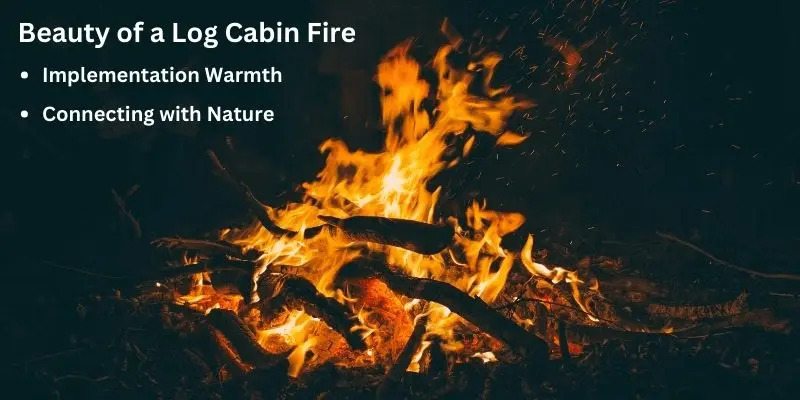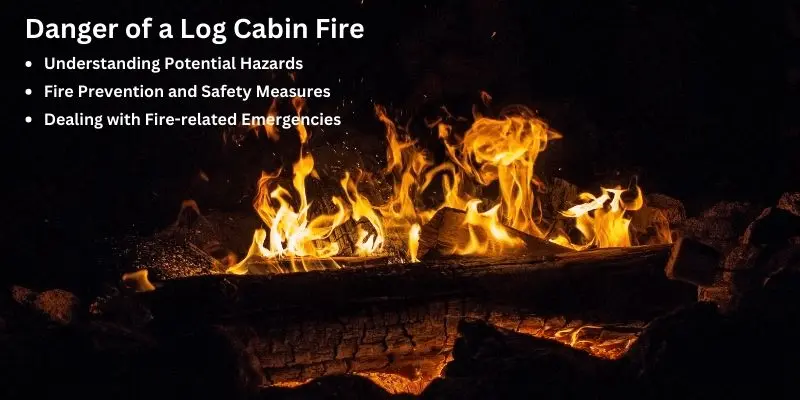Explore the Danger and 2 Factors for Beauty of a Log Cabin Fire
Updated: 28 Jan 2024
216
A log cabin fire holds a unique place in our history and hearts. It is the focal point of cozy gatherings, with its crackling warmth resonating through shared stories and laughter. However, it is crucial to acknowledge the dual nature of a log cabin fire. You should keep in mind about the beauty of a log cabin fire while camping.
This comprehensive blog post will delve into the beauty and danger of log cabin fires, exploring their historical significance, charismatic appeal, and the need for a balanced approach.
The Beauty of a Log Cabin Fire
When camping, it’s important to pick the right tent for your adventure. Consider factors like size, weather resistance, and ease of setup. Once you’ve settled into your tent, imagine sitting by a crackling log cabin fire. The warmth of the flames and the smell of burning wood create a magical atmosphere. Whether you’re camping under the stars or nestled in a cabin, both experiences offer unique joys in the great outdoors.

1. Implementation Warmth
A crackling fire in a log cabin creates a calm environment that soothes the soul. The dancing flames provide a thrilling display that captivates our attention and offers a sense of comfort. The shining glow brings comfort a cold night, making log cabins synonymous with warmth.
Creating a welcoming atmosphere is another aspect of the beauty of a log cabin fire. As friends and family gather around the hearth, they find refuge in its embrace. The crackling fire becomes the heart of the cabin, fostering intimate conversations and strengthening bonds.
Visually, log cabin fires are aesthetically pleasing. The rustic charm of a log cabin combined with the natural glow of the fire creates an inviting environment. The interplay between the hues of orange and gold against the wooden backdrop evokes a sense of timeless beauty.
2. Connecting with Nature
Log cabins provide a unique opportunity to connect with nature, and a fire only enhances this experience. Sitting by a log cabin fire allows us to embrace the outdoors while remaining protected. The crackling fire blends sweetly with the sounds of nature, creating a symphony that enhances the serenity and relaxation of the surroundings.
Moreover, log cabin fires allow us to appreciate the simplicity of fire. It is a basic element that has been a part of human existence for centuries. As we gaze into the flames, we are reminded of our connection to the natural world and the importance of simple pleasures.
Additionally, log cabin fires hold symbolic and cultural significance. Throughout history, fires have been a gathering point for communities. They have served as a source of communication and storytelling, capturing the attention and imagination of those gathered around. Fires have also held spiritual and traditional importance, representing both physical and metaphorical warmth.
The Danger of a Log Cabin Fire
Basic camping skills are essential for staying safe outdoors. One important skill is fire safety. Just like in a log cabin, fires can be dangerous when camping. Remember to clear a safe area for your campfire, away from trees and other flammable materials. Always keep a bucket of water nearby to extinguish the fire when you’re done, and never leave it unattended. Practicing these basic skills can prevent accidents and ensure a fun and safe camping experience.

1. Understanding Potential Hazards
While log cabin fires can be beautiful, it is vital to understand the potential hazards they pose. Mishandling fire is one of the most significant risks.
- Accidents result from negligence
- Improper fire maintenance
- Inappropriate handling of flammable materials
- Ignorance about the proper use of fire can quickly transform the beauty of a log cabin fire into a dangerous situation
Chimney and ventilation concerns are also critical to consider. Failure to maintain a well-functioning chimney can lead to the buildup of dangerous gases such as carbon monoxide. Lack of adequate ventilation increases the risk of smoke inhalation, jeopardizing the safety of log cabin occupants.
Flammable materials and surroundings need to be appropriately managed to reduce the danger of a log cabin fire. Closeness to flammable substances such as
- Branches,
- Dry vegetation,
- Flammable fabrics
The above can increases the risk of an accidental fire spreading uncontrollably.
2. Fire Prevention and Safety Measures
To minimize the dangers, certain precautions must be taken. Installing and maintaining smoke detectors in log cabins is imperative. These lifesaving devices can alert occupants to the presence of smoke or carbon monoxide, providing valuable time to evacuate in case of a fire-related emergency.
Practicing responsible fire management is another crucial step. This includes using seasoned firewood and avoiding the use of accelerants that can lead to uncontrolled fires. It is essential to never leave a log cabin fire unattended, ensuring that someone is always present to monitor its progress and extinguish it properly.
Educating population about fire safety preparedness is paramount. Regular training and awareness programs should be conducted to ensure individuals know how to respond swiftly and appropriately during an emergency.
3. Dealing with Fire-related Emergencies
Despite taking preventive measures, emergencies can still occur. Creating an emergency evacuation plan is essential, ensuring that all occupants are aware of escape routes and designated meeting points. This proactive approach significantly reduces the risk of panic and enhances the chances of personal safety.
In the event of a fire-related emergency, seeking professional help and contacting emergency services is crucial. Firefighters possess the knowledge and equipment necessary to deal with log cabin fires effectively. Promptly alerting emergency services can minimize property damage and ensure the safety of the log cabin’s occupants.
Comparision table between Beauty of a Log Cabin Fire and Danger of a Log Cabin Fire
As much as a log cabin fire can bring warmth and joy, it is important to remember that it can also pose dangers if not handled properly. It is essential to follow safety precautions and maintain the fireplace to ensure the beauty of a log cabin fire does not turn into a dangerous situation.
| Beauty of a Log Cabin Fire | Danger of a Log Cabin Fire |
| Warmth and nostalgia | Potential for house fires |
| Comforting crackle | Hazardous smoke emissions |
| Gathering spot for loved ones | Risk of burns or injuries |
| Symbolic beacon | Possibility of chimney fires |
| Ethereal atmosphere | Potential for carbon monoxide poisoning |
| Invites conversation and laughter | Danger of unattended fires |
| Connection to nature | Flammability of surrounding materials |
| Reflection and gratitude | Risk of structural damage |
With proper care, one can fully appreciate the enchantment and magic of a log cabin fire while keeping themselves and others safe. So, let’s cherish the beauty of a log cabin fire while also being mindful of its potential risks and create cherished memories that will warm our hearts for years to come. But be careful to wilderness.
FAQs
Are there specific types of wood that are recommended for log cabin fires?
It is recommended to use seasoned firewood, such as oak or maple, for log cabin fires. These types of wood burn more efficiently and produce less smoke.
Can log cabin fires negatively impact indoor air quality?
Log cabin fires can impact indoor air quality if the chimney or ventilation system is not functioning properly. Regular maintenance and proper ventilation help ensure that smoke and gases are safely expelled from the cabin.
How often should log cabin owners inspect their chimneys?
Log cabin owners should have their chimneys inspected at least once a year by a professional. Regular inspections help identify and address any potential issues or blockages that can increase the risk of a fire or poor ventilation.
Is it safe to leave a log cabin fire unattended?
No, it is never safe to leave a log cabin fire unattended. Even small fires can quickly escalate, posing a significant risk to the cabin and its occupants. Always ensure that someone is present to monitor and extinguish the fire properly.
Are there any regulations or permits required for having log cabin fires?
The regulations and permits required for log cabin fires vary depending on the location. It is essential to check with the local authorities or fire department to understand the specific requirements and ensure compliance with any applicable regulations.
Conclusion
A log cabin fire encompasses both beauty and danger. It holds a special place in our history and culture, creating an attractive atmosphere while serving as a gathering point for storytelling and community. Yet, it is essential to approach log cabin fires responsibly and with caution. By understanding the potential hazards, practicing fire prevention and safety measures, and being prepared for emergencies, we can appreciate the beauty of a log cabin fire safely and responsibly.
Remember, the beauty and dangers of a log cabin fire coexist. By appreciating it safely and responsibly, we can continue to enjoy the warmth, ambiance, and connection it brings, creating cherished memories for generations to come.
Please Write Your Comments